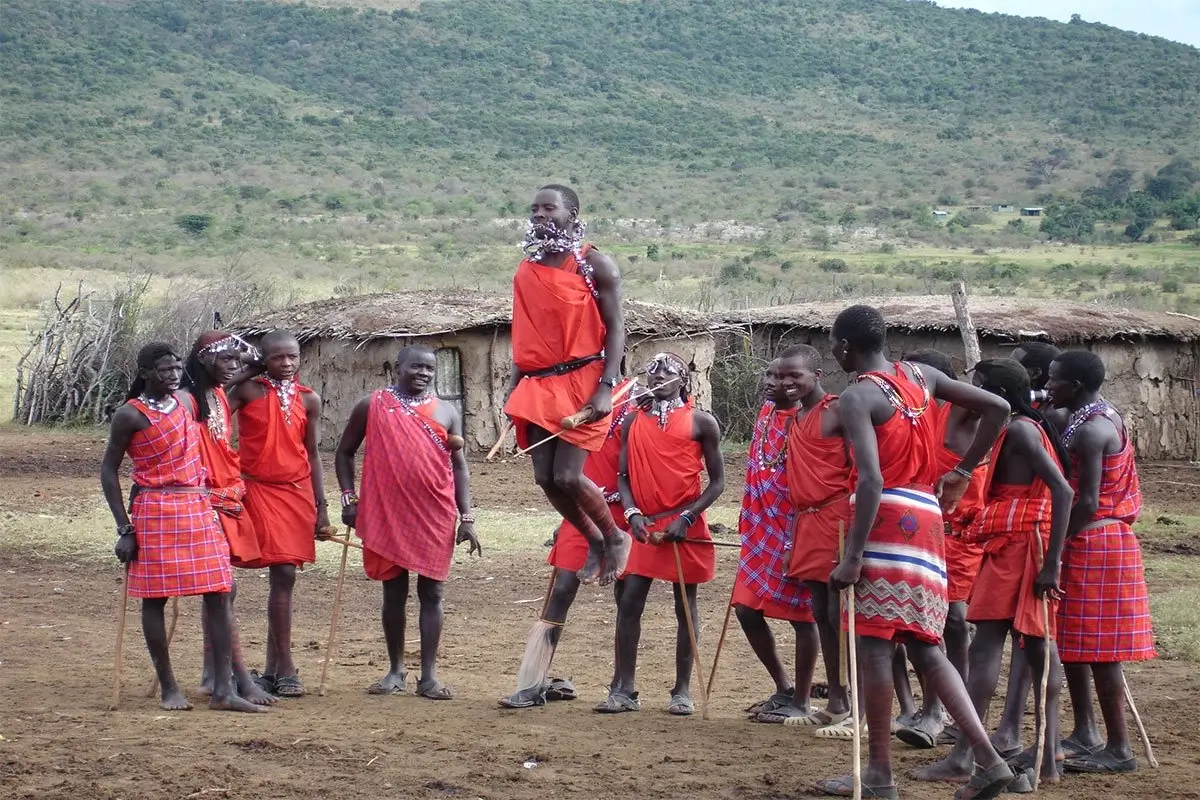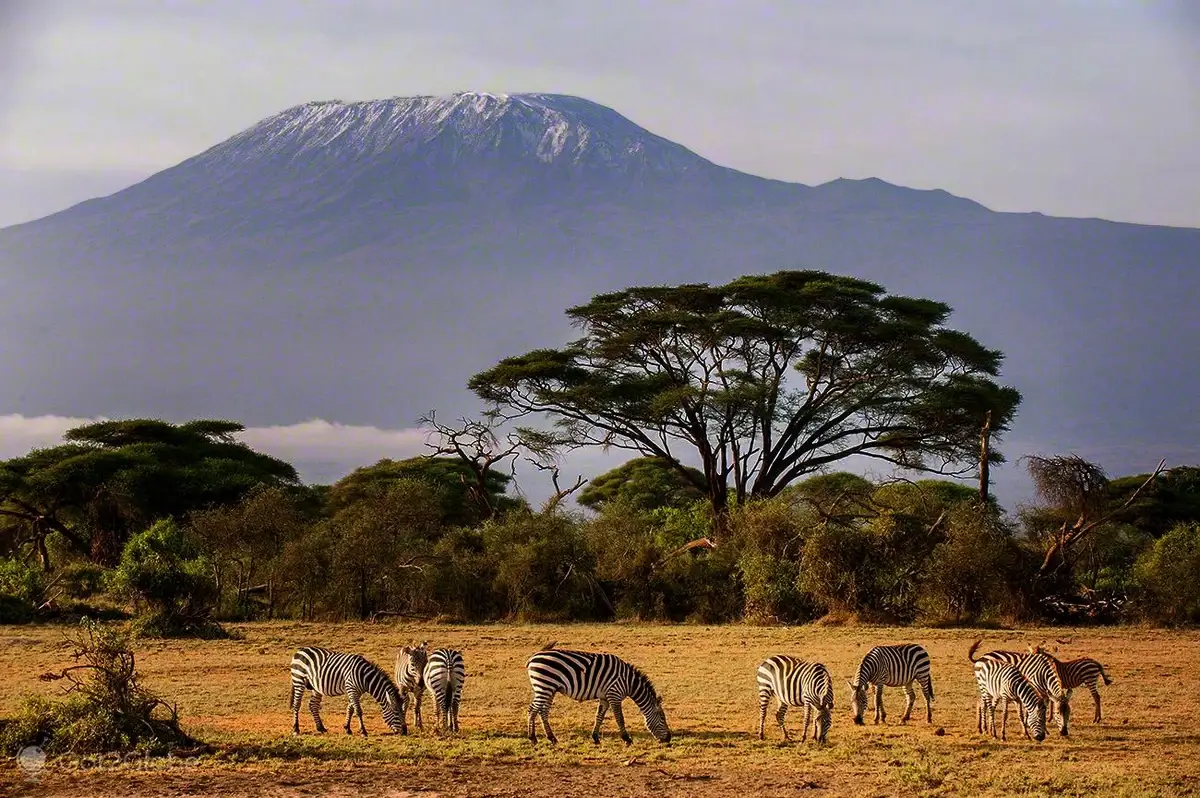Imagine a domain where the earth trembles beneath the mighty strides of the African elephant, the heftiest land creature, amidst baobab trees, dubbed the “Tree of Life,” which hoard water in their massive trunks to survive the arid seasons, while termite mounds tower like natural high-rises. Welcome to the savanna, an environment where blazes revitalize the terrain and the annual journey of wildebeests and zebras manifests as one of the most stunning spectacles of nature.
In this setting, the climate shapes the pace of existence, steering the survival tactics of its varied denizens. Amid this scene of endurance and allure, the savanna’s value transcends its physical breadth, serving as a pivotal element in carbon retention and a haven for threatened species. Embark on an exploration into the fascinating and lively realm of the savanna, unveiling fun facts about the savanna that underscore its essential function in the ecological equilibrium of our world.
1. Savanna Biomes Worldwide: A Global Overview
Savannas are vast grasslands dotted with trees, thriving under hot, seasonally dry conditions. Unlike the common misconception that they are exclusive to Africa, savannas grace almost every continent, from the sprawling plains of Africa to the cerrado of South America, the Australian outback, and parts of India and Southeast Asia. Each of these regions presents a unique savanna ecosystem with distinctive characteristics, flora, and fauna.
Africa is often synonymous with savannas, hosting iconic landscapes like the Serengeti and Masai Mara. These savannas are rich in biodiversity, including the majestic African elephant and big cats like lions and leopards. South America’s savannas, particularly the cerrado, harbor dense tree populations similar to those in tropical forests, with some areas boasting up to 3300 trees per hectare. Australia’s savannas are known for their sclerophyll forests, which, while having tree densities comparable to those in East Africa, offer a starkly different ecological profile with unique species such as kangaroos and wallabies.
The savannas of India and Southeast Asia, less extensive than their African and South American counterparts, still play a critical role in supporting a variety of wildlife. Despite the less pronounced animal diversity, these regions are crucial for the ecological balance and support species adapted to the dry and wet seasonal cycles characteristic of savannas.
2. Vastness of the Savanna
Defined as a mixed woodland-grassland ecosystem with a rarefied tree canopy above a verdant grassy base, the savanna blankets 20% of Earth’s land area, displaying its extensive scope worldwide. Situated within 30 degrees of the equator, savannas are found across Africa, South America, Australia, India, the Myanmar-Thailand stretch in Asia, and Madagascar.
The distinct climate of savannas, characterized by periodic rainfall, nurtures a broad spectrum of plant and animal life, enabling existence to flourish under hot, seasonally arid conditions. The savanna is immense not only in spatial terms but also in biodiversity, playing an integral role in the global ecological equilibrium.

Image: nomadicexperience.com
3. Temperature Extremes in the Savanna
Known for its sprawling grasslands, the savanna biome undergoes a spectrum of temperatures that markedly affect its flora and fauna. Summers in the savanna see temperatures soaring above 80°F, fostering an environment where moisture swiftly evaporates, prompting daily downpours critical for the ecosystem’s sustenance. During the wet season, rainfall amounts to 20 to 50 inches, mainly within a six-to-eight-month span, promoting the growth of lush grasses and supporting diverse wildlife.
Conversely, the winter ushers in a dry season with temperatures ranging from 65 to 70°F, occasionally dipping to 40°F. This period records minimal precipitation, averaging about four inches, with the months from December through February often devoid of rain. The scarcity of rainfall during these months ensures only the most resilient grasses survive, while many other plant species recede.
The savanna cycles through two distinct seasons – a humid, warm summer and a cooler, arid winter. The transitional phases of spring and fall are marked by abrupt climatic shifts, including thunderstorms that ignite the essential fire cycle of the savanna. These fires refresh the soil and foster new growth, crucial for sustaining the savanna biome’s biodiversity.
4. Diverse Animal Life
The savanna is a vibrant ecosystem brimming with a variety of animal species, creating a dynamic balance of life. This biome, primarily known for its expansive grasslands, supports a rich wildlife, from the majestic lions, emblematic of raw power and beauty, to the agile cheetahs, epitomizing speed and grace. The landscape teems with herbivores such as zebras, giraffes, and elephants, each playing a pivotal role in the savanna’s ecological balance.
Herbivores graze the vast grasslands, shaping the vegetation and providing prey for a suite of predators, including hyenas and leopards, which adds to the complexity of the savanna’s food web. This interplay of predation and grazing maintains the health and diversity of the savanna ecosystem. Amongst the acacia and baobab trees, one may also spot the less conspicuous residents – a plethora of bird species, from the large, flightless ostrich to the dazzlingly plumaged roller birds, and the critically important scavengers like vultures.
The diversity of animal life in the savanna is a result of evolutionary adaptations to the environment’s challenges, such as seasonal droughts and fires. These adaptations include migration, camouflage, and specialized feeding strategies, allowing species to thrive in this unique habitat.

Image: ornella.club
5. Sacred Groves in the Savanna
Sacred groves, embedded within the expansive landscapes of the savanna, are more than just untouched natural splendors; they are imbued with spiritual and cultural value. Local communities hold these areas in high esteem, often regarding them as dwellings of ancestral spirits and gods. Such profound reverence guarantees their conservation, aiding in the safeguarding of biodiversity and cultural legacy. The African Savanna, with its emblematic fauna and vast grasslands, shelters these cherished groves, presenting a distinctive amalgamation of natural and spiritual veneration.
In India, the notion of sacred groves occupies a significant status, with over 1 million sacred forests and approximately 150,000 groves. These locales are deeply integrated into the local Hindu societies, where the veneration of nature is a fundamental aspect of their ethical duties. The spiritual ritual of tree worship, deeply entrenched in the belief in cohabitation among all beings, reflects the dynamics of a robust ecosystem, highlighting the critical role of sacred groves in conservation initiatives.

Image: arcgis.com
6. Bird-Watcher’s Paradise in the Savanna
The savanna ecosystem is acclaimed for its abundant bird diversity, rendering it an idyllic destination for bird enthusiasts. Among the plethora of species inhabiting this vast habitat, certain ones are distinguished by their unique traits and behaviors.
- The White-Backed Vulture is instrumental in the ecosystem, clearing away carcasses and thus hindering the spread of diseases.
- The Crowned Lapwing, recognizable by its distinctive crown and sonorous calls, is frequently observed in pairs or small clusters across the grasslands.
- The Grey Crowned Crane, the national bird of Uganda, is celebrated for its elegance and complex courtship dances, augmenting the beauty of the savanna.
- Hornbills, notable for their extended, curved beaks, play a vital role in the ecosystem through seed dispersal.
- The Superb Starling captivates with its brilliant hues and communal behavior, often found in proximity to human settlements where it adeptly adapts.
For bird aficionados eager to delve into the avian life of the savanna, the prime times for observation are during the early morning or late afternoon. The savanna’s open vistas provide an exceptional setting for bird-watching, with species ranging from terrestrial dwellers like the Southern Ground Hornbill to sky-bound performers like the Lilac-breasted Roller.

Image: judys-front-porch.blogspot.com
7. Migration Marvels
The Great Migration in the savanna biome is a breathtaking phenomenon that captivates with its sheer scale and the survival drama it encapsulates. Annually, over 1.5 million wildebeest, accompanied by hundreds of thousands of zebras and gazelles, embark on a perilous journey across the Serengeti plains. This migration is primarily driven by the search for fresh grazing pastures and water, following the seasonal rains and confronting the challenges posed by droughts in the savanna.
The significance of this migration extends beyond the survival of these species; it is crucial for maintaining the health and balance of the savanna ecosystem. Predators such as lions, cheetahs, and crocodiles depend on this migration for food, showcasing a complex interplay of life in the savanna. Furthermore, the movement of such large herds plays a vital role in shaping the landscape itself, affecting vegetation patterns and ensuring the sustainability of this biodiverse habitat.

Image: travelandleisure.com
8. Unique Plant Adaptations
Savanna plants are masters of survival, thriving in an environment where others might falter. Their success lies in remarkable adaptations tailored to withstand long, arduous droughts. Deep-reaching roots are a common strategy, enabling plants like the iconic baobab tree to access subterranean water reserves. This feature not only safeguards them against the scorching dry seasons but also ensures their survival through fires, as their vital components remain unscathed, ready to regenerate.
The flora of the savanna doesn’t stop there; they’ve evolved to efficiently conserve moisture. Some, like the acacia, are equipped with thick, corky bark and specialized organs such as bulbs or corms to store water, tapping into these reserves during the driest times. Others adopt a more aggressive stance against the multitude of grazers, deploying an arsenal of thorns and producing chemicals that render their leaves unpalatable. The acacia, for instance, sends a warning signal to its leaves, altering their taste to deter herbivores, and even hosts protective ants as a living shield against potential threats.

Image: treedom.net
9. Termite Mounds Galore
The savanna is a masterpiece of nature’s architecture, largely thanks to the industrious termite. These insects construct colossal mounds that are not only a testament to their engineering prowess but also a crucial element of the savanna ecosystem. Mound-building termites, such as Macrotermes michaelseni, play a vital role in the savanna’s environmental dynamics by facilitating gas exchange through their meticulously engineered structures. These mounds leverage the Venturi effect and convective flows induced by diurnal temperature oscillations for ventilation, showcasing a sophisticated natural air-conditioning system.
Moreover, the ecological significance of these termite mounds extends beyond mere structural marvels. They are biodiversity hotspots that enhance soil fertility and water retention, offering a lush habitat amidst the otherwise arid landscape. This increased fertility supports dense vegetation on and around the mounds, attracting a variety of herbivores to these “islands” of nutrients. The presence of termite mounds in the savanna is a brilliant example of how even the smallest creatures can have a profound impact on their environment, contributing to biodiversity and ecosystem sustainability.

Image: dissolve.com
10. Wildfire Dynamics in the Savanna
Wildfires in savannas play a critical role in shaping these ecosystems, contrary to the often negative perception of fires. These fires are essential for maintaining ecological balance, aiding in biodiversity, and controlling tree and shrub encroachment. Savannas can remain carbon sinks despite frequent fires, showcasing a complex interplay between fire, vegetation dynamics, and carbon sequestration.
Fire serves both regenerative and destructive roles in savannas, vital for biodiversity and preventing tree encroachment. This balance is crucial for the ecosystem’s health and biodiversity. Despite the carbon emissions from fires, savannas continue to store significant carbon in soil and vegetation. This capacity challenges the simplistic view of wildfires as mere carbon emitters, highlighting a nuanced ecological function.
Indigenous knowledge and practices are increasingly recognized in fire management, including community-based fire management (CBFiM) and savanna burning emissions abatement (SBEA) schemes. These approaches aim to harmonize traditional fire use with contemporary conservation goals, addressing the complexities of fire management in savannas.

Image: alfant.com.au
11. Indigenous Cultures
The savanna is not just a land of diverse wildlife but also a cradle of rich indigenous cultures, each with its own unique relationship to the environment. Among these, the Maasai, Kikuyu, and Dorobo tribes stand out for their distinct ways of life and deep connections to the African Savanna.
The Maasai are perhaps the most iconic, known for their pastoral lifestyle, which revolves around cattle herding. They possess a profound belief in their divine right to cattle, a gift they believe was bestowed upon their ancestors by God. Despite facing challenges such as land loss and epidemics, the Maasai maintain their dominant role in East African cattle herding.
The Kikuyu, residing in the highlands of south-central Kenya, have adapted their agriculture and way of life to the savanna’s conditions. Historically organized into domestic family homesteads, the Kikuyu have a complex social structure based on age sets and clans, with a deep spiritual connection to the omnipotent creator god, Ngai.
The Dorobo, hunter-gatherers of the eastern Serengeti, epitomize the savanna’s earliest inhabitants. They coexist with pastoralists like the Maasai, embodying the savanna’s multifaceted human landscape. Today, they continue to live off the land, hunting small game and foraging for honey and wild fruits.

Image: greatadventuresafaris.com
12. Savanna Ecoregions – Diversity Beyond the Grass
Savannas, vast grasslands dotted with trees, are not just monolithic expanses. They are vibrant ecoregions that vary from tropical and subtropical to Mediterranean and temperate zones, each hosting unique climates and life forms. This diversity extends across continents, from the African plains, famed for their majestic wildlife, to the rolling grasslands of Australia and the Cerrado of South America. These areas are defined by a mix of open canopy and abundant sunlight, supporting a rich herbaceous layer primarily composed of grasses, even as tree density can sometimes rival that of forests.
The variation in savanna types is intrinsically linked to rainfall patterns, soil types, and fire regimes, creating subcategories such as wet, dry, and thornbush savannas. Each type supports its own unique set of flora and fauna adapted to the specific conditions of their environment. For instance, the African savannas are known for their iconic species like lions, elephants, and zebras, while the Australian savannas host unique biodiversity, including kangaroos and various bird species. In contrast, the South American Cerrado is a hotspot for biodiversity, with numerous endemic species.
Human activities have significantly impacted savannas, with grazing and land use changes altering their composition and function. Introduced species, both plant and animal, have further modified savanna ecosystems, sometimes reducing the frequency and intensity of natural fires, essential for maintaining the ecological balance. Despite these challenges, savannas remain crucial for their ecological services, including carbon storage, nutrient cycling, and providing habitats for diverse species.

Savannah of South America. Image: earth.com
13. Iconic Savanna Trees
The savanna is home to some of the most iconic and resilient trees, each with unique characteristics and roles within their ecosystems. From the acacia, synonymous with the African landscape, to the baobab, known as the “upside-down tree” for its peculiar shape, these species are adapted to thrive under harsh conditions.
Acacia Trees stand out for their resilience and adaptability, with deep roots to access underground water and symbiotic relationships with ants for protection against herbivores. Baobab Trees are remarkable for their immense size, longevity, and ability to store water in their thick trunks, making them extremely fire resistant. The Candelabra Tree is noted for its cactus-like appearance and toxic sap, serving as a deterrent to animals and humans alike. The Sausage Tree produces large, sausage-shaped fruits and offers dense foliage for shade. Marula Trees are famous for their sweet fruits, which are enjoyed by various wildlife and used to produce Amarula liqueur.

Image: wallpapercrafter.com
14. African Savanna’s National Parks
African savannas are adorned with national parks that offer breathtaking wildlife experiences and stunning landscapes. Among these, the Serengeti in Tanzania and Masai Mara in Kenya are celebrated for the Great Migration, a phenomenal display of wildlife in motion across the vast grasslands. Botswana’s Chobe National Park is renowned for its large elephant population and diverse wildlife, offering unique safari experiences including river cruises and self-guided tours.
South Luangwa National Park in Zambia introduces visitors to the birthplace of walking safaris, presenting an intimate encounter with the bush, its predators, and vast herds of elephants and hippos. The Ngorongoro Conservation Area in Tanzania is not just a wildlife sanctuary but a geological marvel, housing the expansive Ngorongoro Crater teeming with animals.
Mana Pools National Park in Zimbabwe is praised for its untouched natural beauty and exceptional game viewing, especially along the Zambezi River. Tarangire National Park, less known but equally enchanting, is home to Tanzania’s largest elephant population and a variety of bird species, thriving around the Tarangire River.

Mount Kilimanjaro in Amboseli National Park. Image: got2globe.com
FAQ
What is the biggest savanna in the world?
The largest savanna in the world is the Cerrado in Brazil. It stands out for its vast area, rich biodiversity, and significant ecological importance, representing a major ecosystem within the tropical regions of South America.
What are some famous savannas?
Famous savannas include the Serengeti in Tanzania, renowned for its wildlife migrations, and the Australian savannas, known for their unique ecosystems. The Cerrado in Brazil is also notable for its biodiversity and ecological significance.
How hot can the savanna get?
In savannas, temperatures can range significantly. During the wet season, they can reach up to 20 to 30°C (68 to 86°F), and in the dry season, temperatures can vary from 10 to 20°C (50 to 68°F).
How much of the world is savanna?
Savannas cover about 20% of the Earth’s land surface, demonstrating their significant extent and ecological importance across the globe.





